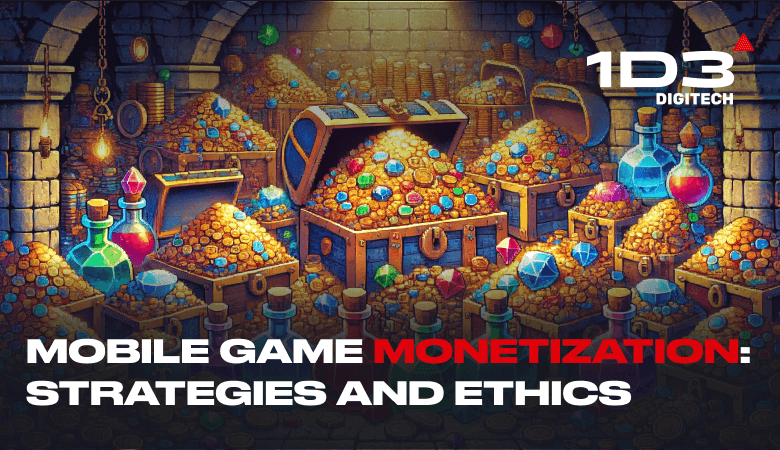Unlocking the Secrets to Successful Mobile Game Monetization

Mobile gaming has taken the world by storm, becoming a billion-dollar industry with endless possibilities. But creating a successful mobile game isn’t just about great graphics or addictive gameplay.
It’s about finding the right way to generate revenue without losing player trust. That’s where mobile game monetization comes in. The lifeline allows developers to fund updates, create new content, and keep the game exciting for players.
Monetizing a mobile game, however, isn’t always straightforward. It requires a deep understanding of your audience, innovative approaches, and balancing profitability and player satisfaction.
In this blog, we’ll explore the secrets to successful mobile game monetization. From understanding your players to overcoming common challenges, we’ll cover everything you need to know to keep your game fun and financially sustainable.
So, let’s unlock the potential of your mobile game!
Understanding Your Audience
To monetize a mobile game effectively, you need to know your players inside and out.
What do they love about your game? How long do they play? What motivates them to spend money?
Answering these questions is the first step to creating a successful mobile game monetization plan.
Different types of players respond to different approaches. For example, casual gamers might prefer rewarded ads, while competitive gamers are likelier to buy power-ups or upgrades.
By analyzing your audience’s behavior and preferences, you can create monetization features that feel natural and valuable.
Don’t forget to use analytics tools. They can help you track player habits, such as how they log in or where they drop off.
This data provides insights that guide your decisions. Additionally, surveys and feedback forms can offer a direct glimpse into what your players want.
Understanding cultural and demographic factors is also essential. For example, players in different regions might have varying preferences for how they want to interact with monetization.
Designing your approach to these nuances can make your strategy more effective globally.
Once you understand your audience, it’s time to build the foundations of successful monetization. Let’s explore the key elements that make it work.
Key Elements of Successful Monetization
Successful monetization isn’t just about throwing ads or purchases into a game. It requires thoughtful integration and creativity.
Here are the key elements that every developer should consider:
1. Seamless Integration
Monetization features should blend seamlessly into the gameplay. Players shouldn’t feel like they’re being interrupted or forced to spend money. For example, offering a rewarded ad option during a tough level feels more like a helpful feature than a cash grab.
The goal is to enhance the player’s experience, not disrupt it. When monetization feels natural, players are more likely to engage with it.
While integration is crucial, staying innovative is equally important. Let’s examine how innovation keeps monetization strategies fresh.
2. Innovation and Creativity
Players love surprises. Adding seasonal events, exclusive challenges, or limited-time offers can keep things exciting.
For example, introducing a special event where players can earn rare rewards through purchases or participation adds a sense of urgency and value.
Innovation also extends to partnerships. Brands can collaborate to offer themed in-game items or experiences, which can generate revenue while keeping the game fresh.
Remember, delivering something unique that aligns with your game’s theme is key.
Another way to innovate is by utilizing new technology. For instance, augmented reality (AR) features can create immersive experiences that players are willing to pay for.
Experimenting with cutting-edge ideas keeps your game ahead of the curve.
While these elements lay the groundwork for monetization, retaining users is just as important. Let’s discuss how user retention impacts revenue.
The Role of User Retention in Monetization
User retention and monetization are like two sides of the same coin. You can’t earn revenue if players leave your game after several sessions.
Keeping players engaged ensures they stick around long enough to interact with your monetization features.
Retention strategies include regular updates, fresh content, and rewarding players for their loyalty.
Daily login bonuses, for instance, give players a reason to come back each day. Similarly, introducing new levels, characters, or features keeps the game exciting.
Social elements also play a big role. Adding leaderboards, multiplayer options, or community events can build a sense of connection among players.
Users who feel invested in your game are more likely to support it financially.
Engagement doesn’t stop at the game itself. Push notifications and email campaigns can remind players of upcoming events or updates. These gentle nudges can re-engage lapsed players and encourage them to return.
With retention covered, let’s explore balancing monetization with player satisfaction.
Balancing Monetization with Player Satisfaction
Monetization should enhance the player experience, not detract from it. Players quickly notice when a game prioritizes profit over fun, which can lead to frustration and negative reviews. Striking the right balance is key.
Here’s how to do it:
- Keep It Fair: Avoid creating a pay-to-win environment. Paid features should offer value without giving an unfair advantage.
- Limit Interruptions: Too many ads or payment prompts can drive players away. Use them sparingly and strategically.
- Be Transparent: Communicate pricing and what players get for their money. Transparency builds trust.
- Offer Free Alternatives: Players can earn rewards through gameplay instead of forcing purchases.
By respecting your players and focusing on their enjoyment, you can help your loyal audience to support your game.
Now that we’ve covered the essentials, let’s wrap up with some final thoughts on successful monetization.
Conclusion
Monetizing a mobile game is both an art and a science. It requires a deep understanding of your audience, seamless integration of features, and a commitment to player satisfaction.
By focusing on retention and innovation, you can create a game that’s profitable and enjoyable for players.
Remember, successful monetization isn’t about squeezing every penny from your users. It’s about building a sustainable model that keeps your game thriving while delivering value to your audience.
So, take the time to analyze, innovate, and refine your strategy. Your players and revenue will thank you!




